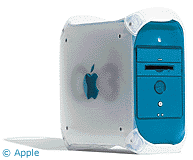This is Low End Mac. We like to tell you
to keep your Macs running until they die, then fix them and keep them
running a bit longer.
Dan's never done a survey, but I suspect our readers are the kind of
folks who buy a car used and run it until it dies, fixing it until the
repair costs exceed the monthly payments on a newer car. Nevertheless,
the presence of smoke, clicking monitors, and the lack of a startup
chime might just inspire you to finally get rid of the beast and seek a
new machine.
We all know the problems with getting rid of old machines - many
landfills won't accept them, and schools are saturated with machines
faster than the one in your closet, so what do you do with the old
beast?
Your local garbage service will advise you about your options, and
when it is finally time to say good-bye, you might have second thoughts
because of sentimental value. If you're in a hurry, perhaps you might
need the Lite Side's
Guide to Stripping Down and Reusing a Computer
Traditional Solutions for Your Typical Mac Pack Rat
CD drives and other spindles: Remove and store in stacks. Really
tall stacks.
Cooling fans: If you have 5-10 of them, you could build your own
G5.
Keep the power cord - at last count, I have 137 of them. Takes three
boxes.
If you have machines that can use it, take out the RAM, unless of
course that is the part that has failed. If humanly possible, label the
number of pins and the amount of RAM.
Remove hard drives and either reformat, reuse, or physically
destroy. Don't lose terminators and ID jumpers!
Apple ImageWriter printers make good bookcases when set on their
sides. HP LaserJets, the kind that used to use a cartridge for fonts,
are also really good for this. All you need is some lumber for the
shelving.
Apple inkjet printers are good for testing your Trebuchet.
Apple LaserWriter printers may still be working; if not, put in a
place where people leave things that get stolen. Someone will take
it.
Old ink and toner cartridges may work somewhere else in another
device; check compatibility charts before chucking.
Internal cables for various components: Sort and store in
Tupperware. If you can see dust in the floppy drive, chuck it. If it
looks clean, put it in the stack. If there isn't one, count yourself
blessed and move on.
Keyboards, cables, mice, mouse balls, and monitor cables all go in
the designated boxes in the storeroom. Mouse balls go in a special jar
that used to hold peanut butter. If it still holds a little peanut
butter, it will cut down on theft of mouse balls.
PCI and other cards, in a bag which is labeled with the
manufacturer name and function. If you like wash windows regularly and
dry dishes by hand, you will probably want to pop a disk with the
driver in the bag, too. An old video-in card can give an old Mac new
life as a television monitor.
Odd little adapters such as older Mac-video-to-VGA, VGA-to-Mac,
etc., in a special little box in the top shelf.
SCSI cables and terminators in a hallowed place.
ADB cables go in the video box with S-video cables.
 Apple Extended Keyboard: Attach to a
Blue and White G3 and
watch people's heads spin.
Apple Extended Keyboard: Attach to a
Blue and White G3 and
watch people's heads spin.
Speakers go in the . . . uh, let's see . . .
speaker box.
LocalTalk cabling (useless for modern Macs) gets put wherever you
put the mice that attach to the original Mac Plus prior to the development of
ADB cables.
Computer-to-speaker cables in the audio box next to those adapters
from the Shack that you never find a permanent use for.
PC cables, such as printer cables, serial keyboard extenders, etc.,
all jumbled up in a big box in the basement. You never know.
If the monitor functions, keep it.
If there is separate VRAM, store and label.
Processor accelerator cards might pick up a few bucks on
eBay or the Low End Mac Swap
List.
Turn the hulk of an all-in-one into a fish tank - a Macquarium.
If you have anything left after all of that, you're on your own!

 Apple Extended Keyboard: Attach to a
Apple Extended Keyboard: Attach to a

